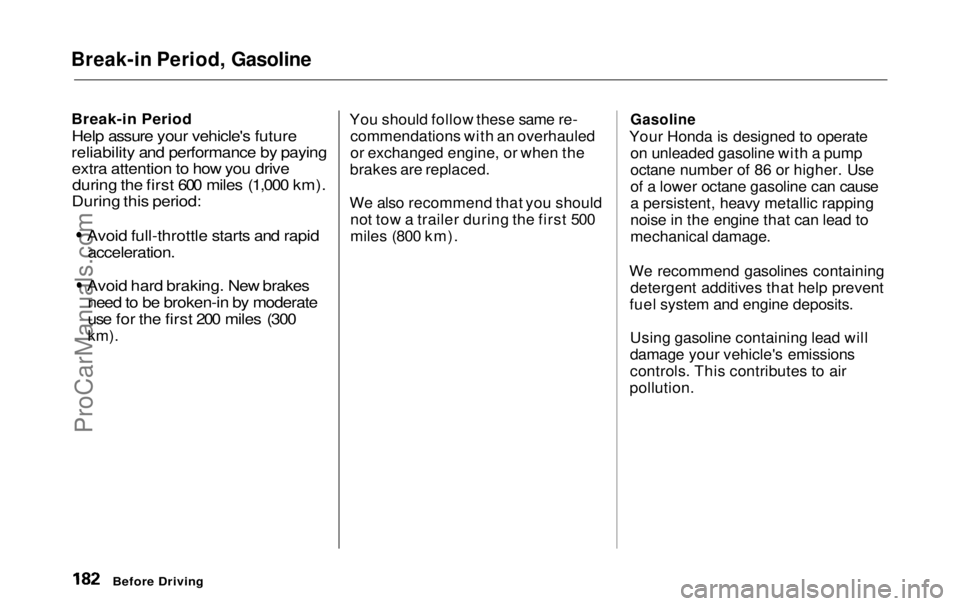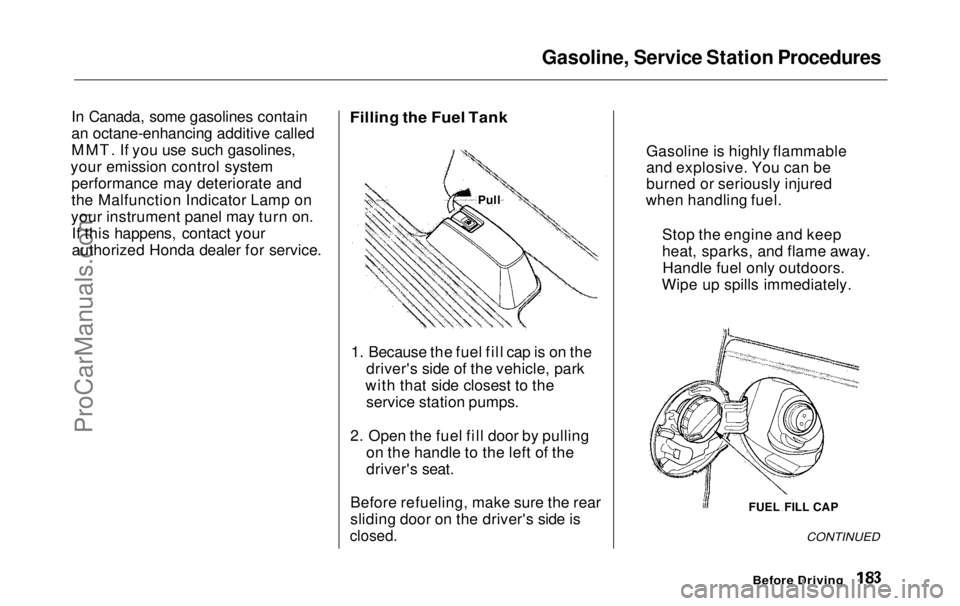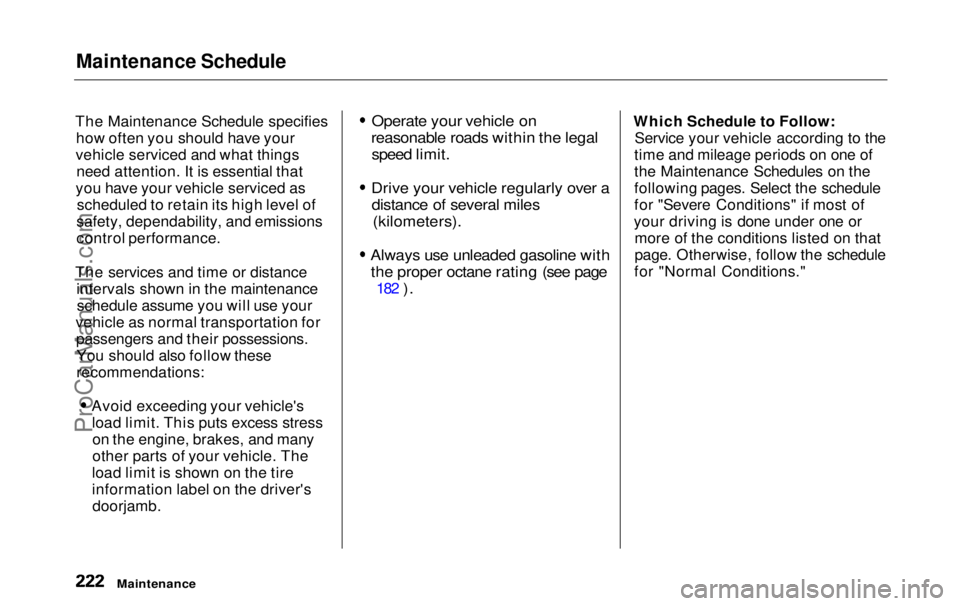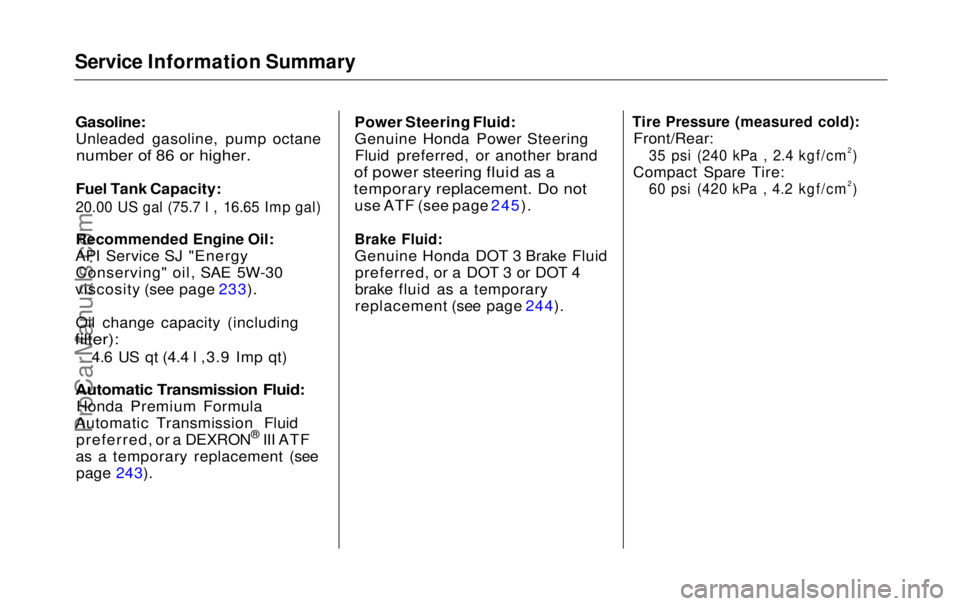1999 HONDA ODYSSEY octane
[x] Cancel search: octanePage 183 of 343

Break-in Period, Gasoline
Break-in Period
Help assure your vehicle's future
reliability and performance by paying extra attention to how you driveduring the first 600 miles (1,000 km).
During this period:
Avoid full-throttle starts and rapid
acceleration.
Avoid hard braking. New brakes need to be broken-in by moderate
use for the first 200 miles (300
km). You should follow these same re-
commendations with an overhauled
or exchanged engine, or when the
brakes are replaced.
We also recommend that you should not tow a trailer during the first 500
miles (800 km).
Gasoline
Your Honda is designed to operate on unleaded gasoline with a pump
octane number of 86 or higher. Use
of a lower octane gasoline can cause
a persistent, heavy metallic rapping
noise in the engine that can lead to
mechanical damage.
We recommend gasolines containing detergent additives that help prevent
fuel system and engine deposits.
Using gasoline containing lead will
damage your vehicle's emissions
controls. This contributes to air
pollution.
Before DrivingProCarManuals.comMain Menu Table of Contents s t
Page 184 of 343

Gasoline, Service Station Procedures
In Canada, some gasolines contain
an octane-enhancing additive called
MMT. If you use such gasolines,
your emission control system performance may deteriorate and
the Malfunction Indicator Lamp on
your instrument panel may turn on. If this happens, contact your
authorized Honda dealer for service.
Filling the Fuel Tank
1. Because the fuel fill cap is on the driver's side of the vehicle, park
with that side closest to the service station pumps.
2. Open the fuel fill door by pulling on the handle to the left of the
driver's seat.
Before refueling, make sure the rear
sliding door on the driver's side is
closed.
CONTINUED
Before Driving
FUEL FILL CAP
Gasoline is highly flammable
and explosive. You can be
burned or seriously injured
when handling fuel.
Stop the engine and keep
heat, sparks, and flame away.Handle fuel only outdoors.
Wipe up spills immediately.
PullProCarManuals.comMain Menu Table of Contents s t
Page 223 of 343

Maintenance Schedule
The Maintenance Schedule specifies how often you should have your
vehicle serviced and what things need attention. It is essential that
you have your vehicle serviced as scheduled to retain its high level of
safety, dependability, and emissions
control performance.
The services and time or distance intervals shown in the maintenanceschedule assume you will use your
vehicle as normal transportation for passengers and their possessions.You should also follow these
recommendations:
Avoid exceeding your vehicle'sload limit. This puts excess stresson the engine, brakes, and many
other parts of your vehicle. The
load limit is shown on the tire
information label on the driver's doorjamb.
Operate your vehicle on
reasonable roads within the legal speed limit.
Drive your vehicle regularly over a distance of several miles (kilometers).
Always use unleaded gasoline with the proper octane rating (see page
182
).
Which Schedule to Follow:
Service your vehicle according to the
time and mileage periods on one of
the Maintenance Schedules on the
following pages. Select the schedule
for "Severe Conditions" if most of
your driving is done under one or more of the conditions listed on that
page. Otherwise, follow the schedule
for "Normal Conditions."
MaintenanceProCarManuals.comMain Menu Table of Contents s t
Page 320 of 343

Oxygenated Fuels
Some conventional gasolines are
being blended with alcohol or an
ether compound. These gasolines
are collectively referred to as
oxygenated fuels. To meet clean air
standards, some areas of the United
States and Canada use oxygenated
fuels to help reduce emissions.
If you use an oxygenated fuel, be
sure it is unleaded and meets the
minimum octane rating requirement.
Before using an oxygenated fuel, try
to confirm the fuel's contents. Some
states/provinces require this
information to be posted on the
pump.
The following are the U.S. EPA and
Canada CGSB approved percentages
of oxygenates:
ETHANOL (ethyl or grain alcohol)
You may use gasoline containing up to 10 percent ethanol by volume.Gasoline containing ethanol may be
marketed under the name "Gasohol."
MTBE (Methyl Tertiary Butyl
Ether)
You may use gasoline containing up to 15 percent MTBE by volume.
METHANOL (methyl or wood
alcohol)
You may use gasoline containing up to 5 percent methanol by volume as
long as it also contains cosolventsand corrosion inhibitors to protect
the fuel system. Gasoline containing
more than 5 percent methanol by
volume may cause starting and/or performance problems. It may alsodamage metal, rubber and plastic parts of your fuel system.
If you notice any undesirable
operating symptoms, try another
service station or switch to another
brand of gasoline.
Fuel system damage or performance
problems resulting from the use of an oxygenated fuel containing more
than the percentages of oxygenates
given above are not covered under
warranty.
Technical InformationProCarManuals.comMain Menu Table of Contents s t
Page 321 of 343

Driving in Foreign Countries
If you are planning to take your
Honda outside the U.S. or Canada,
contact the tourist bureaus in the
areas you will be traveling in to find out about the availability of unleaded
gasoline with the proper octane
rating.
If unleaded gasoline is not available,
be aware that using leaded gasoline
in your Honda will affect perfor- mance and fuel mileage, and damage
its emissions controls. It will no
longer comply with U.S. andCanadian emissions regulations, and
will be illegal to operate in North
America. To bring your vehicle back into compliance will require the re-
placement of several components, such as the oxygen sensors and the
three way catalytic converter. These
replacements are not covered under
warranty.
Technical InformationProCarManuals.comMain Menu Table of Contents s t
Page 336 of 343

Index
Emergencies on the Road Brake System Indicator............ 304
Changing a Flat Tire................. 287
Charging System Indicator...... 302
Checking the Fuses................... 305
Low Oil Pressure Indicator...... 301
Malfunction Indicator Lamp.... 303 Overheated Engine................... 299
Emergency Brake.......................... 116
Emergency Flashers....................... 70
Emergency Towing....................... 311
Emissions Controls........................ 323
Engine
Coolant Temperature Gauge ..... 63
Drive Belts.................................. 256
Malfunction Indicator
Lamp............................... 58, 303
Oil Pressure Indicator........58, 301
Oil, What Kind to Use...............
233
Overheating................................
299
Specifications.............................
317
Ethanol i n
Gasoline .......................
321
Evaporative Emission
s
Controls..
323
Exhaust Fumes...............................
.
53
Exhaust Gas Recirculation System......................................... 324 Expectant Mothers, Use of Seat
Belts by......................................... 20
Exterior, Cleaning the................... 278
Fabric, Cleaning............................. 280
Fan, Interior...........................130, 142 Features, Comfort and Convenience............................... 129
Filling the Fuel Tank..................... 183
Filters
Air................................................246
Air Conditioning........................ 256
Oil................................................ 235
First Gear Position......................... 201
Flashers, Hazard Warning.............. 70
Flat Tire, Changing a.................... 287
Fluids
Automatic Transmission...........
243
Brake...........................................244
Powe r
Steering........................... 245
Windshield Washer................... 242
FM Stereo Radio Reception............................150, 162
Folding the Third Seat..................110
Foreign Countries, Driving in...... 322
Four-way Flashers........................... 70
Front End, Towing by Emergency
Wrecker...................................... 311
Fuel..................................................182
Fill Door and Cap....................... 183
Gauge............................................ 63
Octane Requirement................. 182
Oxygenated................................ 321
Reserve Indicator......................... 61
Tank, Filling the......................... 183
Fuses, Checking the...................... 306
Gas Mileage, Improving................ 188
Gasohol........................................... 321
Gasoline.......................................... 182
Fuel Reserve Indicator................ 61
Gauge............................................ 63
Octane Requirement................. 182
Tank, Filling the......................... 183
Gas Station Procedures................. 183
Gauges
Engine Coolant Temperature .... 63
Fuel................................................63ProCarManuals.comMain Menu s t
Page 338 of 343

Index
Leaking of Exhaust into Vehicle ... 53
Light Control Switch..................... 125
Lights
Bulb Replacement..................... 266
Indicator........................................ 57
Interior........................................ 125
Parking.......................................... 66
Turn Signal................................... 68
Load Limits............................. 192, 212
LOCK (Ignition Key Position)....... 78
Locks Anti-theft Steering Column........ 78
Fuel Fill Door............................. 183Glove Box..................................... 87
Lockout Prevention..................... 80
Power Door.................................. 79
Sliding Doors................................ 88
Tailgate......................................... 85
Low Coolant Level......................... 187
Low Fuel Indicator.......................... 61
Low Oil Pressure Indicator.... 58, 301
Lubricant Specifications Chart.... 316
Luggage.......................................... 191 Maintenance................................... 219
Owner Maintenance Checks.... 231
Record.................................. 229-230
Required Indicator....................... 64
Safety........................................... 220
Schedule.............................. 224-228
Malfunction Indicator Lamp.. 58, 303
Manual Sliding Doors...................... 88
Maximum Allowable Speeds........ 201
Meters, Gauges................................ 62
Methanol in Gasoline.................... 321 Mirrors, Adjusting......................... 115
Moving the Second Row Bucket
Seat..............................................106
Neutral Gear Position.................... 200
New Vehicle Break-in ................... 182
NOTICE, Explanation of.................... i
Numbers, Identification................ 314
Octane Requirement, Gasoline.... 182
Odometer.......................................... 62
Odometer, Trip................................ 63
Oil
Change, How to ......................... 235
Change, When to....................... 224
Checking Engine....................... 186
Pressure Indicator............... 58, 301
Selecting Proper Viscosity Chart....................................... 234
ON (Ignition Key Position) ............ 79
Opening the Hood......................... 184
Operation in Foreign Countries... 322
Outside Mirrors............................. 115
Overheating, Engine..................... 299
Owner Maintenance Checks........ 231 Oxygenated Fuels.......................... 321
Paint Touch-up...............................279
Panel Brightness Control............... 67
Park Gear Position......................... 199
Parking............................................ 203ProCarManuals.comMain Menu s t
Page 343 of 343

Service Information Summary
Gasoline:
Unleaded gasoline, pump octane
number of 86 or higher.
Fuel Tank Capacity:
20.00 US gal (75.7 l , 16.65 Imp gal)
Recommended Engine Oil:
API Service SJ "Energy Conserving" oil, SAE 5W-30
viscosity (see page 233).
Oil change capacity (including
filter):
4.6 US qt (4.4 l ,3.9 Imp qt)
Automatic Transmission Fluid:
Honda Premium Formula
Automatic Transmission Fluid preferred, or a DEXRON ®
III ATF
as a temporary replacement (see page 243). Power Steering Fluid:
Genuine Honda Power Steering
Fluid preferred, or another brand
of power steering fluid as a
temporary replacement. Do not
use ATF (see page 245).
Brake Fluid:
Genuine Honda DOT 3 Brake Fluidpreferred, or a DOT 3 or DOT 4
brake fluid as a temporary
replacement (see page 244).
Tire Pressure (measured cold):
Front/Rear:
35 psi (240 kPa , 2.4 kgf/cm2)
Compact Spare Tire:
60 psi (420 kPa , 4.2 kgf/cm2)ProCarManuals.comMain Menu s t